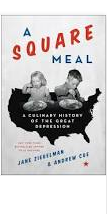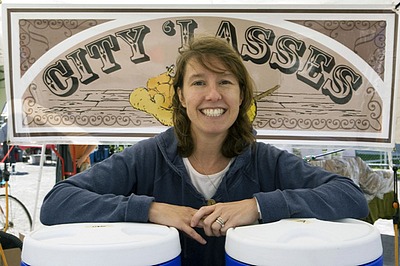We think of the Depression as a time of food scarcity, our vision shaped by John Steinbeck’s great novel “The Grapes of Wrath” and Walker Evans’ images. Breadlines. Bankers selling apples. Those impressions don’t tell the whole story, as Jane Ziegelman’s and Andrew Coe’s fascinating history “A Square Meal” makes clear. Thrift and making do were definitely part of what was happening in America’s Depression kitchens, but big changes were underway as well. Electrification, mechanization, nutritional research and government food policies all developed during the 1930s. Eighty years later, we are still feeling the effects.
The United States had (and continues to have) enormous food resources, and Ziegelman and Coe use an illuminating example to open their history: during World War I Americans cut back consumption, allowing huge quantities of grains and meats to be shipped overseas, where they fed soldiers a diet that could reach 5000 calories a day. After the war, mechanization of farms and electrification meant fewer hands were needed to produce this harvest, consumption returned to normal levels, and returning soldiers, and their sisters, left the farms they’d grown up in and flooded into cities where manufacturing jobs awaited them.
In the cities, apartments were much smaller than rural farmhouses, and kitchens (which often became “kitchenettes”) were tiny. Delis, cafeterias, and sandwich shops provided fast meals at a low price; obtaining food was efficient (Ziegelman and Coe write, they “followed the same ideals of industrial efficiency and mass production as Henry Ford’s factory,” even as they offered a substantially greater number of products). There was a cost, in lost knowledge – once bread became widely available fewer people learned how to bake.
No system was prepared when the economic crash came. The federal government and most of the state governments argued that charity was a private concern, and the first response to the need for food was bread lines. Ziegelman and Coe report that bread lines had been in use during the 1920s as a seasonal – and private – response to the food needs of men drawn to cities to work on construction projects, then a warm weather activity. (Ziegelman and Coe make the bread line atmosphere sound too rough for most women, though there were some. It’s an interesting footnote in this time of new awareness of the many kinds of sexual harassment.)
When it became clear those efforts would not be sufficient, New York City, under Mayor Jimmy Walker, tried a new approach in 1930: using city government structures to supply families with fuel, clothing and food. Ziegelman and Coe write:
To pay for all that emergency help, the mayor would tap the city’s 125,000 municipal workers, asking that they each donate 1 percent of their monthly salaries . . . This was not a charity, [Mayor Walker] told them, but a wholesome example of neighbor helping neighbor, exactly the kind of relief advocated by President Hoover.
The police compiled a list of families in need and distributed the food, along with instructions about how to “wring the most nutrients” from the potatoes, cabbage, turnips, dried peas and cereals provided. But once the school year started, teachers noticed that children were missing school – and when truant officers investigated, they found children lacking food and clothing. The City’s response was to transform schools into emergency assistance centers, using teachers to identify students who might be in need. This echo of the contemporary Community Schools effort differed from the present in that it was funded by monthly contributions from Board of Education employees (and gave out aid on the spot). Sometimes school lunch was a child’s only meal of the day.
New York State began providing food relief soon after (Franklin Roosevelt was still the state’s governor, and Harry Hopkins ran the program). New York planned carefully, included nutritional guidance and menu planning assistance for limited budgets, and still made mistakes: social workers followed women to grocery stores to ensure that they were spending as little money as possible, and meals could be dreary, repetitive and not necessarily nutritious. Despite fears of increasing dependency, grocery orders were replaced with cash assistance. Ziegelman and Coe write, “If work was the best kind of help a person could receive, money was second, a lesson [Hopkins] carried to his next job as the director of federal relief under President Roosevelt.) Then as now, the state and localities split the cost of the relief.
At the federal level, Ziegelman and Coe describe Herbert Hoover as remote, entertaining lavishly at the White House and leaving food relief to the states. It was an approach that worked until Americans started to die of starvation. In 1932 FDR was elected president; and Ziegelman and Coe devote the last portion of “A Square Meal” to the various federal government food relief efforts. The Agricultural Adjustment Administration, which distributed food, came first, and was followed quickly by the Civilian Conservation Corps, Works Progress Administration, and the Federal Transient Program – all programs that required people to work for food because, in yet another repeat of a debate still underway, there was concern (and some evidence) that relief without work created dependency.
There’s much more in the book: Food and farm policies that resulted in low prices produced farmers who dumped food in protest, creating what Walter Lippmann called “the paradox of want amid plenty.” The relief programs ended just as the Dust Bowl got underway (though, Ziegelman and Coe write, most of the displacement we credit to the Dust Bowl was the result of changes in farming practices, not the weather). The development of home economics and the combination of that science with new learning about nutrition. Ziegelman and Coe intersperse meals plans and recipes throughout their text. Cracked whole wheat, for example, became the basis for a slew of nutritious if frugal menus. (It’s yet another theme that echoes today – savory oatmeal is touted as a healthy alternative.) The continuing development of the science of nutrition, which gave menu planning at all parts of the income scale a solid scientific basis — but when taken up by increasingly centralized food manufacturing and distribution networks, it also meant the beginning of practices that torment us today, such as milling all the nutrition out of wheat (so we can have soft white bread) and then supplementing the resulting loaf with artificial nutrients.
For anyone interested in food policy, cooking, eating, and nutrition, “A Square Meal” provides a fascinating and well-written introduction to policies that still affect us today. It’s a worthy companion to the other books in your food library, and a useful reminder of the limits of our knowledge.
Have a book you want me to know about? Email me at asbowie@gmail.com. Follow me on Twitter @abowie917.


